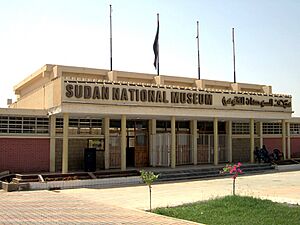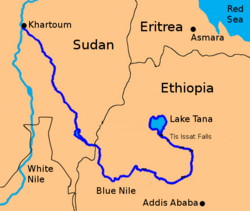Sudanese civil war (2023–present) facts for kids
Quick facts for kids Sudanese civil war (2023–present) |
||||||||||
|---|---|---|---|---|---|---|---|---|---|---|
| Part of the Sudanese Civil Wars | ||||||||||
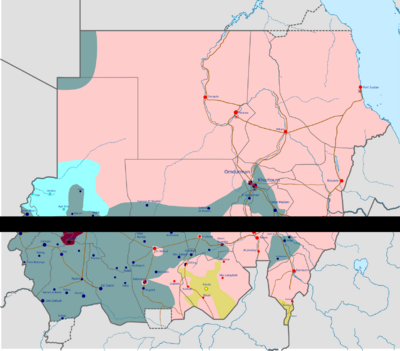 Military situation as of 7 July 2025[update] Controlled by Sudanese Armed Forces and allies (Transitional Sovereignty Council) Controlled by Rapid Support Forces (Government of Peace and Unity) Controlled by SPLM-N (al-Hilu) Controlled by allied Rapid Support Forces and SPLM-N (al-Hilu) Controlled by SLM (al-Nur) (Detailed map) (Engagements) |
||||||||||
|
||||||||||
| Belligerents | ||||||||||
Supported by: |
Supported by: Wagner Group |
|||||||||
| Commanders and leaders | ||||||||||
|
|
|
||||||||
| Strength | ||||||||||
| ~300,000 |
120,000 total fighters (14 April 2023, per SAF)
104 armored personnel carriers 171 vehicles with machine guns |
Unknown | ||||||||
| Casualties and losses | ||||||||||
|
||||||||||
A civil war started in Sudan on 15 April 2023. It is a fight between two main groups: the Sudanese Armed Forces (SAF), led by General Abdel Fattah al-Burhan, and the Rapid Support Forces (RSF), a powerful group led by Mohamed Hamdan Dagalo, also known as Hemedti. Other smaller armed groups have also joined the conflict.
The fighting has been mostly in Khartoum, the capital city, and in the Darfur region. Many people in Darfur have been killed in what some call ethnic cleansing or genocide. Sudan is facing a very serious humanitarian crisis, with almost 25 million people suffering from extreme hunger. In January 2025, the United States said that the RSF and its allied groups had committed genocide.
Sudan has had many problems since it became independent in 1956, including many attempts to take over the government and two long civil wars. This current war began because of disagreements about how the RSF should join the regular army. The RSF attacked government places in Khartoum and other cities. Khartoum was then split between the two sides.
Many attempts to stop the fighting have failed. Different rebel groups have joined either side. By late 2023, the RSF controlled most of Darfur and made progress in other areas. However, the SAF gained strength in early 2024 and took back control of Khartoum by March 2025. The war is still going on, causing huge problems for people and affecting nearby countries.
The war has caused a terrible famine, leading to the deaths of an estimated 522,000 children from lack of food. The total number of people killed by violence, starvation, and disease is much higher. Thousands more are missing or have been killed in massacres. As of February 2025, over 8.8 million people have had to leave their homes but are still in Sudan, and more than 3.5 million have fled to other countries as refugees.
Other countries have been involved, sending weapons or supporting one side. The war has led to severe shortages of food, water, and medicine. Hospitals have closed, diseases have spread, and many people have been forced to move. More than half of Sudan's population needs urgent help. Both the SAF and RSF have used disinformation on social media to try and control what people think. Because of the conflict, countries like the United States and the United Kingdom have placed sanctions on people and groups involved in the fighting.
Contents
- Sudan's History of Conflict
- The War Begins
- Early Battles in Khartoum
- Jeddah Peace Talks
- Fighting Continues in Khartoum
- Diplomatic Efforts and SPLM-N Involvement
- Darfur Front
- SAF Struggles in Darfur
- Peace Talks and RSF Crossing the Nile
- Hemedti's Travels and Continued Fighting
- SAF Gains in Omdurman
- Fighting in Darfur and Kordofan (2024-2025)
- Fighting Along the Nile (2024-2025)
- SAF Offensives (Late 2024)
- Offensives in 2025
- Khartoum's Liberation
- April and May 2025 Offensives
- June and July 2025 Offensives
- Other Countries Involved
- Impact on People
- International Reactions
- Disinformation
- Sanctions
- See also
Sudan's History of Conflict
Sudan has a long history of military takeovers. Since it became independent in 1956, there have been 20 attempts to overthrow the government. The military has usually been in charge, with only short times of democratic rule.
Two major civil wars happened before this one. The first was from 1955 to 1972, and the second from 1983 to 2005. These wars, mainly between the government and southern regions, caused 1.5 million deaths and led to South Sudan becoming an independent country in 2011. A conflict in the Darfur region also forced two million people from their homes and killed over 200,000.
The Darfur War and RSF's Start
Around the year 2000, the Darfur region in western Sudan faced many problems due to ethnic tensions and fights over land and water. In 2003, this led to a big rebellion against the government. The president at the time, Omar al-Bashir, used strong force to stop it. This conflict, known as the War in Darfur, involved widespread violence by the government, leading to accusations of war crimes and genocide against al-Bashir.
To fight the rebels, al-Bashir used a group of Arab militias called the Janjaweed. In 2013, he changed the Janjaweed into the Rapid Support Forces (RSF) and put Mohamed Hamdan Dagalo (Hemedti) in charge. The RSF was accused of terrible acts like mass killings and destruction of villages. They were also accused of ethnic cleansing against certain non-Arab groups.
In 2017, a new law made the RSF an "independent security force." Hemedti became very rich from gold mines given to him by al-Bashir. The RSF grew very large, with tens of thousands of fighters and many armed vehicles. They even patrolled the streets of Khartoum. The government allowed the RSF to grow to prevent other parts of the army from trying to take power.
Political Changes in Sudan
In December 2018, protests against al-Bashir's rule began. In April 2019, the military, including the RSF, removed al-Bashir from power. The army then formed a military council. Protests continued, asking for civilian rule. In June 2019, security forces, including the RSF and SAF, killed many protesters in Khartoum.
In August 2019, the military agreed to share power with civilians in a temporary government called the Transitional Sovereignty Council. This government was supposed to lead to elections in 2023. However, in October 2021, the military, led by Abdel Fattah al-Burhan and Hemedti, took power again in a coup. This stopped Sudan's move towards democracy.

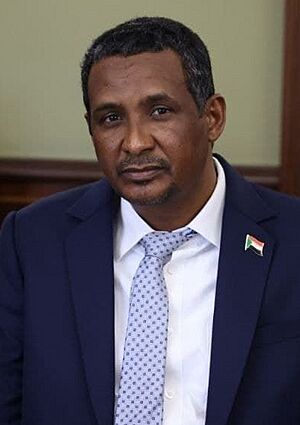
Groups Involved in the Conflict
The Sudan Liberation Movement (SLM) is a rebel group from Darfur, mostly made of non-Arab people who felt left out by the government. It split into several groups. By 2023, the main groups were SLM-Minnawi, SLM-al-Nur, and SLM-Tambour. Some of these groups signed peace deals, but SLM-al-Nur kept fighting.
The Sudan People's Liberation Movement–North (SPLM-N) was formed by soldiers who stayed in Sudan after South Sudan became independent. They started a rebellion in southern states. In 2017, the SPLM-N split into two groups: one led by Abdelaziz al-Hilu and another by Malik Agar. Al-Hilu wanted Sudan to be a secular (non-religious) state. Agar's group signed a peace deal in 2020 and joined the government. Al-Hilu's group later signed a separate agreement.
What Led to the War
After the 2021 military takeover, Sudan's economy got much worse, leading to more protests. Tensions grew between al-Burhan and Hemedti. Hemedti was worried that al-Burhan was bringing back old government officials who didn't like him because of his background.
In February 2023, the RSF started recruiting more members across Sudan. They gathered forces in Khartoum, causing fears of a rebellion. Talks between the SAF, RSF, and civilian leaders were delayed because they couldn't agree on how the RSF would join the army. The RSF wanted 10 years for this to happen, while the army wanted it done in two years.
On 11 April 2023, RSF forces moved near the city of Merowe and in Khartoum. The government told them to leave, but they refused. This led to clashes when the RSF took control of a military base south of Khartoum. On 13 April, the RSF began to move their forces, making people fear a war. The SAF said these movements were illegal.
The War Begins
Early Battles in Khartoum
On 15 April 2023, the RSF attacked SAF bases all over Sudan, including Khartoum and its airport. There were fights at the state TV station, which the RSF later took over. Bridges and roads in Khartoum were closed. The next day, the SAF fought back, taking back Merowe Airport and the TV station.
The country's airspace was closed, and internet services were shut down. International trade also stopped.
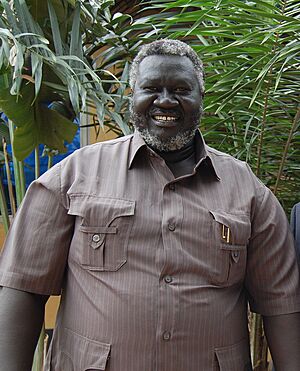
Hemedti ordered his forces to capture or kill al-Burhan. Al-Burhan managed to escape, but his base was surrounded by the RSF. Hemedti claimed the RSF was fighting against radical groups and asked other countries to help against al-Burhan.
Even though a ceasefire was announced for a holiday, fighting continued. By early May, the SAF said they had weakened the RSF. The police also joined the SAF. The SAF launched big attacks on the RSF in Khartoum using air strikes and artillery, causing a lot of damage.
Al-Burhan, still trapped, gave a public speech saying he would keep fighting. On 19 May, he removed Hemedti as his deputy and replaced him with Malik Agar. Agar then became the acting leader of the Sudanese government, handling peace talks and international visits.
Jeddah Peace Talks
Other countries became concerned about the conflict. On 6 May, SAF and RSF representatives met in Jeddah, Saudi Arabia, for talks. On 20 May, they signed the Treaty of Jeddah, promising to protect civilians and aid workers. However, the agreement did not include a ceasefire, and fighting continued, especially in Geneina.
The situation remained dangerous, with both sides blaming each other for attacks on hospitals and embassies. Many people were killed, especially in Geneina, where Arab militias linked to the RSF were accused of violence against non-Arab people. A temporary ceasefire was signed but was often broken.
Fighting Continues in Khartoum
In June, tank battles continued in Khartoum. The RSF took control of important buildings, including the National Museum of Sudan. Many people in Sudan faced severe food shortages.
In July, the SAF tried to rescue al-Burhan from his surrounded base, but their forces were defeated by the RSF. Both sides increased their attacks, causing many civilian deaths.
Heavy fighting continued in Khartoum in August. The RSF surrounded a key SAF base. The SAF also attacked RSF-controlled areas. One of the few remaining bridges connecting parts of Khartoum was destroyed by the SAF to stop the RSF from moving freely.
On 24 August, the SAF successfully rescued al-Burhan from his base. He then went to Port Sudan and held a government meeting there.
Diplomatic Efforts and SPLM-N Involvement
Ceasefires were announced but often broken. The Sudanese government took action against international representatives. With al-Burhan out of Khartoum, he traveled to Egypt, South Sudan, and other countries to meet with leaders. He also went to the United Nations, asking them to call the RSF a terrorist group.
The Abdelaziz al-Hilu group of the Sudan People's Liberation Movement–North (SPLM-N) broke its ceasefire in June, attacking SAF units. The SAF said they fought back, while the rebels claimed they attacked to protect civilians. This led to many people being displaced. In February 2025, the SPLM-N (Al-Hilu) officially joined the RSF.
Darfur Front
In Darfur, fighting was very intense around the city of Geneina. The RSF was accused of violence against the Masalit people, leading to accusations of ethnic cleansing. In August, the RSF claimed full control over Central Darfur.
The United Nations found many mass graves in Darfur. The RSF and Arab militias were accused of killing lawyers, doctors, and tribal leaders. The governor of West Darfur was killed after accusing the RSF of genocide. The SAF also carried out air strikes that killed many civilians.
Some tribal and rebel groups in Darfur joined either side. The SLM-Tambour group supported the SAF, while the Tamazuj group joined the RSF. Fighting also spread to North Kordofan.
SAF Struggles in Darfur
By October 2023, the SAF in Darfur faced severe supply shortages. On 26 October, the RSF captured Nyala, Sudan's fourth-largest city. This was a big win for the RSF, as Nyala has an airport and border connections, making it easier for them to get supplies. After Nyala, the RSF took over Zalingei without much resistance.
In Geneina, the RSF surrounded the SAF base. The base was captured two days later, and many soldiers were taken prisoner. Witnesses reported mass killings by the RSF in the town of Ardamata. With Geneina's fall, only Ed Daein and Al-Fashir remained under government control in Darfur.
The RSF also took over Umm Keddada. Ed Daein fell in November. In response to the RSF's gains and violence, the Justice and Equality Movement and SLM-Minnawi stopped being neutral and declared war on the RSF.
Peace Talks and RSF Crossing the Nile
New peace talks in Jeddah in late October failed, as neither side would agree to a ceasefire. Negotiations were stopped in December. The East African group IGAD then hosted a peace summit, where Hemedti and al-Burhan agreed to meet in the future.
The RSF attacked Wad Ashana in North Kordofan and an oil field in West Kordofan. By late October, the RSF controlled most of Khartoum, but al-Burhan's government had moved to Port Sudan.
The RSF increased attacks in Khartoum and Omdurman. The Shambat Bridge, which connected Khartoum North to Omdurman, was destroyed in November. This cut off an important supply route for the RSF. To get a new crossing, the RSF attacked the Jebel Aulia Dam. After a week-long battle, the RSF captured the dam on 20 November.
In December, the RSF moved into Gezira State, advancing towards its capital, Wad Madani. The RSF took control of Rufaa and entered the Butana region. After several days, the RSF seized the Hantoob Bridge and entered Wad Madani. The army offered little resistance, and the RSF took over the city.
The fall of Wad Madani was a major setback for the SAF, opening up large parts of the country to RSF attacks. The RSF captured most of Gezira and made progress in White Nile State. Al-Burhan urged civilians to mobilize and fight the RSF.
Hemedti's Travels and Continued Fighting
After Wad Madani fell, efforts to negotiate a ceasefire continued. Hemedti went on a diplomatic tour, meeting with African leaders and former Prime Minister Hamdok. He tried to present himself as Sudan's leader and improve his image.
Al-Burhan, however, refused to negotiate, saying the RSF had committed war crimes. In January 2024, the Sudanese government suspended its ties with IGAD, ending their peace efforts.
The RSF attacked South Kordofan in early 2024. In January, the RSF attacked Babanusa after surrounding it for months. By 25 January, the RSF controlled the city center.
In December 2024, the SAF launched an offensive in southern Gezira, recapturing Wad el-Haddad and Um al-Qura. In January 2025, the SAF made big gains in Gezira and North Kordofan. They recaptured Haj-Abdallah, Al-Shabarga, and other villages. On 11 January, the SAF retook control of Wad Madani.
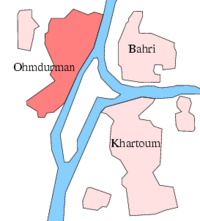
The SAF also launched an operation in North Kordofan, capturing the Umm Ruwaba district. By February, the SAF had recaptured Al-Hasaheisa, Tambul, and Rufa'a, leaving the RSF in control of only a small part of Gezira. The SAF also lifted the siege of El Obeid.
SAF Gains in Omdurman
The SAF gained ground in Omdurman in February 2024, connecting their forces and ending a 10-month siege in the city center. They also took control of the Al-Hilal Stadium. This was the first major breakthrough for the SAF.
In March 2025, the SAF controlled most of Omdurman. They took control of the Libya Market and launched new attacks in Ombada, west of Omdurman.
Fighting in Darfur and Kordofan (2024-2025)
On 15 April 2024, during the Battle of El Fasher, the RSF launched a new attack on Al-Fashir in North Darfur, killing many civilians. The Joint Darfur Force declared war on the RSF and allied with the SAF.
The fighting in El Fasher used up SAF resources, slowing down their plans to retake Khartoum and Wad Madani. The SAF used its limited air power to strike in North Darfur and resupply El Fasher. The battle in El Fasher has been intense, with concerns about mass killings. In June 2024, a top RSF commander was killed in El Fasher. Many villages around El Fasher were burned. Fighting continues in El Fasher, which is the SAF's last stronghold in Darfur.
In May 2024, fighting continued in Babanusa, West Kordofan, as the RSF tried to take control of the area. On 20 June 2024, the RSF captured Al-Fulah, the capital of West Kordofan, after the SAF left the city. The SAF retreated to Babanusa, their last base in Kordofan.
Fighting Along the Nile (2024-2025)
In May 2024, the RSF attacked SAF positions between Khartoum State and River Nile State, and in White Nile State. In June 2024, the RSF still controlled Khartoum and Khartoum North, but the SAF held small areas that they supplied by air.
In late June 2024, the RSF attacked areas around Sennar. They captured Singa, the capital of Sennar State, on 29 June. This made it harder for the SAF to reinforce Sennar. After Singa fell, the RSF occupied other towns with little resistance.
In July, a top RSF commander was killed in Sennar. On 3 August, the RSF attacked Blue Nile State for the first time. On 15 August 2024, the RSF carried out the Galgani massacre, killing at least 108 people.
SAF Offensives (Late 2024)
By September 2024, the SAF seemed to be gaining strength. On 26 September, the SAF launched a major attack on RSF positions in Khartoum from three sides. SAF air strikes and ground clashes began. The SAF reportedly captured three key bridges connecting Khartoum to other cities. However, the SAF faced tough urban fighting.
October 2024 was the deadliest month for civilians. The RSF heavily shelled SAF-controlled areas, and SAF air strikes also caused many civilian deaths. The SAF launched counterattacks in Sennar and Gezira, recapturing them from the RSF. In October 2024, the RSF carried out massacres in eastern Gezira, killing at least 300 people.
By November 2024, the war had entered a very dangerous phase. Both sides said they would not negotiate and would fight until one side won completely. Many Sudanese people, even those who criticized the SAF, started supporting them because of the RSF's actions. The SAF became more reliant on Islamist groups, who helped mobilize civilians. On 23 November, the SAF retook Singa.
Offensives in 2025
The SAF retook Wad Madani on 11 January 2025. On 8 February 2025, the SAF regained control of almost all of Khartoum North and prepared to retake Khartoum itself. On 24 February 2025, the RSF claimed to have shot down a Russian-made plane in Nyala. The RSF also declared a rival government in Nairobi, Kenya, which the SAF did not recognize.
Khartoum's Liberation
On 20 March 2025, the SAF announced they were close to the Presidential Palace and captured it the next day. On 22 March, the SAF also retook the headquarters of the Central Bank of Sudan and the General Intelligence Service in Khartoum. They also recaptured Tuti Island and Khartoum International Airport. On 26 March, al-Burhan announced the liberation of Khartoum. By 20 May, the SAF said they had cleared Khartoum State of the RSF.
April and May 2025 Offensives
In April 2025, the RSF launched a major attack in North Darfur to capture El Fasher, the last state capital under SAF control. The RSF claimed control of Zamzam camp after intense fighting that killed over 200 civilians. The SAF denied using the camp for military purposes.
On 1 May 2025, the RSF announced they had taken control of En Nahud, a key city in West Kordofan. On 5 May, the RSF attacked Port Sudan for the first time using drones.
Despite some setbacks, the SAF retook Al-Khiwai in West Kordofan on 11 May, and Al-Hamadi in South Kordofan on 13 May. They also regained some areas in southern Omdurman. On 19 May, the SAF took Wadi al-Atrun, a strategic location. By 20 May, the SAF claimed to have fully expelled the RSF from Khartoum state. On 21 May, the SAF said they had cleared White Nile State of the RSF. On 23 May, the SAF captured the strategic city of Dibebad in South Kordofan.
June and July 2025 Offensives
On 10 June, the RSF and the Libyan National Army attacked the border area linking Sudan, Libya, and Egypt. By 16 June, the RSF had captured the entire Sudan-Libya border. On 22 June, the SPLM-N (al-Hilu) cut off the road between Kadugli and Dalang, putting them under siege. On 26 June, the SAF recaptured Malken in Blue Nile State. The SAF launched a counterattack on 28 June, reopening the road between Dalang and Kadugli.
On 7 July 2025, the SAF announced they had taken control of the area around Kazgeil, which connects North and South Kordofan.
Other Countries Involved
Many countries have been involved in the conflict, often by supplying weapons.
Chad
Chad has been accused of supporting the RSF by allowing military equipment and fighters to pass through its territory. In December 2023, Sudan expelled four Chadian diplomats due to these accusations. In November 2024, Sudan filed a complaint against Chad, asking for payment for its support of the RSF.
China
China has supplied weapons to both the SAF and the RSF, even though there is an arms ban on Darfur. China officially says it doesn't support either side, focusing on stability to protect its economic interests. China's plans for trade routes in the Red Sea have been delayed by the war. In January 2025, China donated emergency food aid to Sudan.
Egypt
Egyptian troops were in Sudan for military exercises when the war started. Some were captured by the RSF but later released. Egypt has supported the SAF, with reports of Egyptian fighter jets bombing RSF positions.
Eritrea
Eritrea is seen as an ally of the SAF, providing military support near Sudan's eastern borders. Eritrea's president has hinted that his country is ready to respond if the RSF advances towards its borders.
Ethiopia
Ethiopia initially supported the RSF but later shifted its position, with its Prime Minister visiting al-Burhan in Port Sudan in July 2024. In July 2025, Sudanese officials accused Ethiopia of using the civil war to take control of disputed land near the border.
Iran
A BBC investigation in June 2024 found that Iran supplied drones to both sides, going against a UN arms ban. This is seen as part of Iran's plan to gain influence in Sudan and access the Red Sea.
Kenya
The SAF rejected Kenya's role in peace talks, accusing its president of supporting Hemedti. Sudan even threatened to leave an African group unless Kenya's president was removed from mediation efforts. In February 2025, Kenya hosted a meeting where the RSF formed a rival government, which Sudan condemned.
Libyan National Army
The Libyan National Army (LNA), led by Khalifa Haftar, has sent military supplies to the RSF. The LNA has worked with the Russian Wagner Group to deliver these supplies.
Russia
Russia has sent weapons to both the RSF and SAF. In mid-2024, Russia started to favor the SAF, possibly due to talks about building a Russian naval base in Sudan.
Wagner Group
The Wagner Group, a Russian private military company, has been accused of supplying missiles and other weapons to the RSF. They reportedly brought weapons from Syria and the Central African Republic. The head of the Wagner Group and the RSF denied these claims. As Russia's relations with the SAF improved, the SAF claimed Wagner was no longer in Sudan, but some reports disagreed.
Saudi Arabia
Saudi Arabia has supported the SAF, trying to balance the UAE's influence, which supports the RSF. In March 2025, al-Burhan visited Saudi Arabia and thanked them for their support.
South Sudan
South Sudan has tried to mediate peace in Sudan, as it is worried about the war's effects on its own stability, like refugee flows. A new alliance between Sudan's RSF and the SPLM-N in February 2025 could pull South Sudan deeper into the conflict.
Turkey
Turkey seems to be involved with both sides. A Turkish company, owned by President Erdoğan's son-in-law, sold weapons to the SAF in 2023. Another Turkish company had contact with the RSF. Turkey is interested in expanding its military and diplomatic ties in Africa. In January 2025, Somalia agreed to host SAF troops for training as part of a Turkish-led effort.
Ukraine
In September 2023, reports suggested that Ukrainian special forces were behind drone strikes and ground operations against the Wagner Group-backed RSF near Khartoum. Ukraine's intelligence chief did not confirm or deny this but said Ukraine would hunt down Russian military criminals.
United Arab Emirates
The UAE has been accused of providing military support to the RSF, including weapons and drones, often disguised as aid. Reports from major news outlets and satellite evidence suggest Emirati planes delivered weapons through Chad. The UAE has denied these accusations.
Sudan has expelled Emirati diplomats and accused the UAE at the UN of helping with genocide. Sudan also filed complaints against the UAE in international courts. The UAE's involvement is believed to be linked to its influence and gold interests in Sudan. The US and UK have asked the UAE to stop its support. In April 2025, UAE authorities said they stopped illegal ammunition shipments to the SAF, which the SAF denied. In May 2025, a court dismissed Sudan's case against the UAE for genocide.
United Kingdom
In June 2024, reports said that UK government officials tried to stop criticism of the UAE's alleged role in supplying arms to the RSF. The UK is also the main country responsible for Sudan issues at the UN Security Council. Sudan's Deputy Chairman criticized the UK in December 2024, asking them to pressure the UAE to stop supporting the RSF.
United States
In May 2023, the US President authorized sanctions against those causing instability in Sudan. Sanctions followed, targeting companies linked to both the SAF and RSF, and individuals involved in human rights abuses. In January 2025, the US said the RSF and its allies committed genocide and imposed sanctions on Hemedti and related groups. However, some critics said these actions were too late. In May 2025, the US announced new sanctions on Sudan for the SAF's use of chemical weapons.
Impact on People
Humanitarian Crisis
The fighting has made life very hard for people, especially during hot weather and drought. Civilians are afraid to leave their homes for food and supplies. Hospitals are understaffed and lack supplies. The World Health Organization (WHO) reported many attacks on healthcare facilities. Most hospitals in conflict areas are not working. Diseases like measles and cholera have spread.
In April 2023, the United Nations said there were severe shortages of food, water, medicine, and fuel. Food aid worth millions of dollars was stolen. By June 2023, about 25 million people, more than half of Sudan's population, needed help. Attacks on aid facilities led to many warehouses being looted and vehicles stolen.
In September 2023, the UN said 1,200 children had died from disease in refugee camps. UNICEF estimated that 19 million children were out of school. The war has caused huge economic damage, especially in Khartoum. Food prices have increased, and aid convoys are rare. Both the SAF and RSF have made it hard for food aid to reach people.
Amnesty International reported in June 2024 that foreign weapons from China, the UAE, Russia, and Turkey are fueling the war and causing massive displacement and a humanitarian crisis.
Famine
Almost 25 million people, half of Sudan's population, are facing extreme famine. In August 2024, experts confirmed famine conditions in parts of North Darfur, including the Zamzam refugee camp.
In late January 2025, the US government froze some foreign aid, which led to the closure of hundreds of soup kitchens and more deaths from starvation. By February 2025, famine had taken hold in at least five regions, with over 600,000 people at risk. Aid groups had to stop operations in some camps.
Sudanese groups have been accused of using famine as a weapon by attacking fertile areas, displacing farmers, and blocking aid. Observers are calling for safe aid zones and for those responsible to be held accountable.
Refugees
As of February 2025, over 12.3 million people in Sudan have been forced to leave their homes. More than 8.8 million are displaced within Sudan, and over 3.5 million have fled to other countries. This makes Sudan the country with the most internally displaced people in the world. Many people from Darfur fled to Chad to escape ethnic attacks.
The conflict has caused economic activity in Sudan to drop sharply. The value of property and goods stolen is estimated at billions of dollars. Gold production has also decreased. The finance minister said Sudan's economy shrank by 40 percent in 2023. More than 60 percent of Sudan's farmland is out of use. Both the RSF and SAF are using money from selling gum arabic to fund their operations.
International Reactions
A UN official warned in April 2025 that Sudan faces the world's worst humanitarian crisis. There are calls for more aid, protection for aid workers, safe ways for refugees to find safety, and for the UAE to stop sending weapons to the RSF.
Disinformation
Both the SAF and RSF have used social media to spread false information and control public opinion. They used fake videos from video games or past conflicts. For example, the SAF posted a video of alleged air operations that was actually from a video game. The RSF shared fake footage of planes being shot down.
The RSF also sent information to UK politicians to counter what they called "disproportionate" disinformation. Facebook removed RSF pages in August 2024. Experts warn that AI might be making fake content more believable, making it harder to trust information.
Sanctions
United States
The US has imposed sanctions on individuals and companies linked to the SAF and RSF for breaking ceasefires and human rights abuses. These sanctions targeted leaders and firms involved in supporting the conflict. In January 2025, the US determined that the RSF and allied militias committed genocide and sanctioned Hemedti and related groups. In May 2025, the US announced new sanctions on Sudan for the SAF's use of chemical weapons.
Other Countries
In July 2023, the United Kingdom sanctioned firms linked to both sides for providing funds and weapons. In April 2024, Canada imposed sanctions on individuals and groups linked to the SAF and RSF. In June 2024, the European Union sanctioned six entities for making and buying weapons for the SAF and RSF. In March 2025, Canada sanctioned al-Burhan and Hemedti for not wanting to negotiate an end to the war.
See also
 In Spanish: Guerra civil sudanesa (2023-presente) para niños
In Spanish: Guerra civil sudanesa (2023-presente) para niños
- Sudanese Civil War, an index of three major civil wars that occurred in Sudan's history, as well as other separate conflicts in Sudan.
- Janjaweed (Janjaweed Coalition)
- Human rights in Sudan
- War in Darfur
- Darfur genocide
- 2021 Sudan coup d'état
- Timeline of the Sudanese civil war (2023)
- Timeline of the Sudanese civil war (2024)
- Timeline of the Sudanese civil war (2025)
- List of civil wars
- List of conflicts in Africa
- List of ongoing armed conflicts
- List of wars: 2003–present


